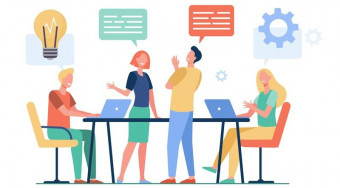Introductory Sport Psychology
Tags: Sport Psychology
Developing sport psychology skills that you can use when you train, compete or coach
Last updated 2022-01-10 | 4.1
- By the end of this course- students should have an appreciation of the different types of tools sport psychologists use when working with athletes to improve their sporting performance
- Students should be able to recognise when and how to use each tool
What you'll learn
* Requirements
* There are no academic prerequisites for this course* although some experience as a coach or athlete is desirable
* This course is required to be completed BEFORE undertaking the Advanced Sport Psychology course (by this author) on Udemy
Description
This sport psychology course teaches students how to apply sport psychology tools on themselves or others. Everything you need for the course will be provided, including Powerpoint slides and video. Students could reasonably be expected to complete this course over 4-8 weeks if working on 1-2 topics per week. The course is structured to be undertaken sequentially. This course would suit people wanting to learn more about themselves as athletes or coaches, or to see how sport psychologists work with athletes and coaches. The course gives you information, and an opportunity to use this information on yourself or others, but does not include assessment.
For students wanting to complete exercises and assessment that might lead to an academic qualification (eg SISSCGP310A 'Support athletes to adopt principles of sport psychology' - this course has recently had the course code changed to SISSCO308A to better reflect its Sports Coach content), or complete professional development points for coaching accreditation, I recommend you continue and undertake the assessment for the Advanced Sport Psychology course on Udemy (both the Introductory and Advanced courses are required to be completed to establish competency).
Who this course is for:
- This course is suitable for students aged 15 or more years of age
- Those wanting a general knowledge about how sport psychologists work with athletes and coaches will appreciate and benefit from undertaking this course
- Students are most likely to be athletes, coaches, or sport psychology students
- Students hoping to gain an academic qualification or professional development for coaching accreditation would be welcome to do this course in the first instance, and then might choose to undertake the assessment in my Advanced Sport Psychology course on Udemy
Course content
3 sections • 24 lectures
What is sport psychology? Preview 04:31
This chapter describes who, how, where, when and why sport psychologists work with athletes and coaches.
Chapter 1 What is sport psychology?
This 5 question quiz will allow you to see if you have understood material from this Chapter.
Who can benefit from sport psychology techniques? Preview 04:27
This chapter describes the benefits and pitfalls of working with individuals and teams of varying ages and abilities.
Chapter 2 Who benefits from using a sport psychologist?
This 5 question quiz will allow you to see if you have understood material from this Chapter.
How do you become a sport psychologist? Preview 05:32
This chapter describes the academic requirements to become a sport psychologist (in Australia), their job prospects, and how someone might benefit from the sport psychology skills taught in this Udemy course.
Chapter 3: How do I become a sport psychologist?
This 5 question quiz will allow you to see if you have understood material from this Chapter.
Relaxation Preview 06:35
This chapter looks at different forms of mental and muscle relaxation, and talks about when and where to use them.
Chapter 4: Relaxation
This 5 question quiz will allow you to see if you have understood material from this Chapter.
Visualisation / Imagery Preview 06:16
This visualisation lecture talks about how to use key words and images (and their purpose), and how to divide your event into segments where you might use internal and external visualisation to rehearse your event. Pre-shot visualisation is also discussed.
Chapter 5: Visualisation
This 5 question quiz will allow you to see if you have understood material from this Chapter.
Psyching Up and Psyching Down Preview 29:56
This chapter illustrates how, historically, the arousal and performance relationship has evolved over time (including Drive theory, Inverted U hypothesis, Zones of Optimal Functioning, Multidimensional Anxiety theory, Catastrophe theory, and Reversal theory). You'll learn how to psych yourself (or your team) up, or down, using somatic and/or cognitive strategies suggested in this chapter.
Chapter 6: Psyching up and psyching down
This 5 question quiz will allow you to see if you have understood material from this Chapter.
Goal Setting Preview 19:21
This chapter describes how to do three types of goal setting - lifetime goal setting; spiderweb profile; and achievement management plan - and provides blanks for you to fill in to do the exercises yourself.
Chapter 7: Goal Setting
This 5 question quiz will allow you to see if you have understood material from this Chapter.
Controlling Distractions and Expectations Preview 05:38
This chapter identifies the types of internal and external distractions that seek to disrupt concentration, and gives you a tip to remind yourself to remain focused on thinking and acting productively.
Chapter 8: Controlling Distractions and Expectations (Concentration)
This 5 question quiz will allow you to see if you have understood material from this Chapter.
Confidence Preview 03:43
This chapter discusses the fleeting nature of confidence - what builds it up and what kills it off.
Chapter 9: Confidence
This 5 question quiz will allow you to see if you have understood material from this Chapter.
Leadership and Communication Preview 06:02
Chapter 10 identifies leadership behaviours, and talks about developing the right culture for your team. 'Communication' is a major skill within the leadership arsenal - it prevents conflict - and is important for leaders to develop a good communication style so members of the team can see, feel, and carry out the leader's vision.
Chapter 10: Leadership and Communication
This 5 question quiz will allow you to see if you have understood material from this Chapter.
Resources Preview 03:10
Chapter 11 lists some free or low cost resources I recommend you check out.
Building Resilience Preview 07:44
This track is large (92MB) but is made available for those who would like to download it to their devices. It was designed to be used by healthy people to remind themselves of productive positive behaviours used by resilient people. These include: positive beliefs; having a sense of purpose; reconnecting with spirituality; developing and maintaining a social network; embracing change; being optimistic; nurturing oneself; developing a problem-solving mindset; establishing goals; and, continuing to work on these skills.
It starts with a relaxation sequence, which enhances the body's ability to take on new information (in the first instance) and/or put the listener into a state where self evaluation in a calm way is possible. As such, listeners must not be driving or operating heavy machinery whilst using these tracks as reflexes and decision-making required for external distractions may be impaired.
Case study: Recovery from Injury (Part 1) Preview 10:00
This case study was first presented by me at the 7th Victorian Sport Psychology Conference in Melbourne, Australia, in December 2013.
I have two fabulous sons, but this is the story of my eldest boy, Philip. Phil trains at the High Performance Centre as a level 10 gymnast, with the aim of representing Australia one day. He also works at Bounce, a trampolining centre where he referees and coaches. He loves doing both these activities. Not long after he turned 20, he injured himself doing a flipping routine off a tramp and into an inflatable mat. He said he just 'lost himself in the air' (which can happen in a tumbling routine, but 99.9% of time the landing might be awkward, but it all ends up ok). This time he landed on his neck close to the edge of the mat (where it was not quite so soft).
He heard a crack and felt pain, and was about to get up (as you do when you're a young man performing in front of friends) when he heard the Manager at Bounce call out to him not to move and lie still. I'm so grateful that she did. An ambulance was called right away, and the call was made to me at home. (I was told that he'd landed on his neck but that he reported that he could feel his fingers and toes. I was very thankful for that good sign.)
By the time my youngest son and I arrived at Bounce, the mat had been deflated and Phil was surrounded by ambulance paramedics, and his friends (standing a little bit away to keep out of the way of the ambulance crew but also not to move the mat in any way) were calling out encouragement and joked about a bit with him. Phil was in a bit of pain. I was pretty shocked - it felt like I was watching a movie - but I was trying to hold it all together and remain calm.
The paramedics were brilliant. Phil was loaded into the ambulance, and with their lights and sirens operating, we followed the ambulance in my car to The Alfred Hospital (not too far from Bounce). Traffic was light as it was about 10pm on a Sunday night by this stage. Phil was taken in for assessing, and Mike and I were left in the waiting room...where we waited...and waited... It turned out it was a busy night at The Alfred, with no beds to admit him. We were told he would have x-rays as soon as possible, but hadn't happened by the time Mike and I left the hospital after midnight. The Emergency Department was so full that patients were on trolleys in the corridor, and we were able to chat quietly with Phil there for a little while before we left.
The next morning, after dropping Mike at school (and me not having work), I was back at The Alfred to see how Phil was going. He was out of the corridor and into a cubicle in Emergency (still in a neck brace), where he'd 'sort of' slept the night. At about 1.30am the previous night Phil was taken to get x-rays where they thought they couldn't see spinal damage and decided his injury was ligament damage instead. After spending the morning in the cubicle, he was moved to a different section of Emergency in the afternoon, and the next day was admitted to the Trauma Unit up on a different floor. He spent 24 hours there and was discharged after the neurosurgeon told him he'd be wearing a collar (neck brace) for 6 weeks to allow the ligaments to heal.
We fully expected that after 6 weeks, the collar would be off and he'd be able to resume training...
Case study: Recovery from Injury (Part 2) Preview 13:37
Phil and I went to the neurosurgeon's appointment after Phil had spent 6 weeks in a collar, and were gobsmacked to hear that x-rays taken the week before had shown that Phil's neck hadn't repaired itself yet, and that he'd be faced with 6 more weeks in a collar. (The next day, Phil was to have a meeting with an independent medical examiner, organised by the WorkCover Insurance company, to see if he was ready to start back at work. Phil and I were to meet at the doctor's office at the appointed time as we were travelling separately. Phil got lost in the city and couldn't find the doctor's office and the appointment was missed. As a consequence of not turning up, the insurance company took the view that Phil was malingering and cut off his payments. We tried to present a case that Phil was lost - and probably still shell-shocked from the bad news of the previous day, but the insurance company was adamant that they didn't need to pay his medical bills or his part salary any more. We took them to an independent Tribunal to have this verdict overturned, and presented telephone evidence of Phil and I trying to locate where he was and how to get to the location, but the insurance company weren't interested in varying their decision. The day before the Tribunal was to meet, the person appointed to hear the case had the chance to read our evidence, and he immediately ordered the insurance company to reinstate Phil as a client.)
In the meantime, about 3 weeks after the 6 week checkup, a closer inspection of Phil's x-rays by a group of neurosurgeons at The Alfred resulted in Phil being transferred to a more senior neurosurgeon to have surgery on his damaged C5 and C6 vertebrae. It wasn't just ligament damage after all! It took a little while for the insurance company to recognise Phil's right to have his medical bills paid for (see previous paragraph), but once that was sorted, Phil had surgery at The Epworth Hospital. He was told to expect to recover in hospital for 6-8 days, but Phil's recovery was much faster than that - he was out in less than 24 hours! (I know I recover well from surgery and have a high tolerance to pain and an aversion to drugs, and told Phil he was most likely to be the same as me. That and the fact that he's an incredibly fit young person - and most people having this type of spinal surgery was due to degeneration due to age - so Phil was always likely to be on the 'lesser time spent in hospital' end of the curve than most of the doctor's patients.)
After I'd brought Phil home from hospital, and he'd been quietly recuperating and I'd been at work during the day, I remember I took a call from the neurosurgeon who sounded a bit sheepish. He said he'd never had anyone recover so well and so fast before, and it seemed so unnecessary to hold such a 'well' patient in hospital...was Phil still OK and pain free? I assured him that he was recovering brilliantly and was on no pain medication at all (having cut down the doses as pain abated). The neurosurgeon reiterated the need to call him if pain returned or there was tingling in the fingers. Luckily, neither of these things eventuated.
I'm writing this now in October 2014, not quite 14 months since the accident (25th August 2013). Phil has been back at training for about 6 weeks. He's building up strength - as he would normally do at this time of the year, albeit this year he's coming off a lower base of training to begin with - for the 2015 gymnastics season (which will commence in March). He's been pain free all this time. With the vertebrae joined at C5 and C6, he has slightly less movement in his neck than he would normally have, but as far as we are concerned, he's made a full recovery. He has a last check up with the neurosurgeon in January 2015, but we're expecting that to be fine.
We view this journey as a 'bit of a hiccup' in Phil's gymnastics career, but the year off might help renew his enthusiasm for training (not that it really needed 'renewing' at the time) and give some 'wear and tear' injuries a chance to heal properly - so far, so good - so it might even prolong his gymnastics career. (The other concern I had was that Phil would lose interest with gymnastics after so long out of the sport, but to date, this hasn't happened.)
I want to thank Phil for allowing me to document his journey. I thought it might be useful for others to see what happened along the way, and what strategies we used. I can't say we both aren't scarred a little (Phil literally, and me figuratively...I can't watch a segment on TV about a person needing to be put in a collar without wanting to burst into tears, so obviously it has affected me on an emotional level), but I am so grateful for all the love and care Phil received (the ambulance crew, The Alfred, The Epworth, Phil's own doctor at HPC, the staff at Bounce, his mates and the coaches at gymnastics, and family and friends). Thank you.








 This course includes:
This course includes:
















